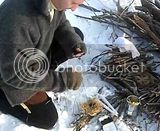To Get a fire going, have a handful of twigs( VERY DRY- SHOULD PASS THE SNAP TEST) beginning the size of toothpicks, and working up to the thickness of your little finger. If you can find any Yew bushes, or firs, or even Juniper bushes in the area, you can find dead twigs on the inside of the green outer layers of needles. Break those off and sort them by size. For larger logs, look for dead trees standing virtically in the shadow of larger trees in the forest. The bark will be peeling, and evidence of wood pecker activity and wood bore or termite activity will be visible. Usually, you can kick these over, and the 20 foot tall, and maybe 4" diameter "trees" will provide you will many hours of dried logs. I have chopped on these trees with an axe, but to be honest, its a lot fast simply putting the log across two logs, and then jumping on the middle of the 6-8' span to break the log in half. Put the long logs onto a fire, and burn it in half. Then you can push, or pick up and move each half into the fire for more convenience. I learned this the first time I was chopping such a dead log, and my second hit caused the tree to break in half under my axe. I then realized just how dried out the wood was inside this dead tree, and began kicking and jumping on the rest of the log to break it down into manageable lengths.
You will soon learn to hold your tinder above your eyebrows before you blow the embers into the tinder to get a fire. Don't ask me, please, how I know that! :grin: :surrender: :thumbsup:
Put the smallest sized twigs in the form of a tipi over your burning tinder, then ad the next size, working always around the fire making another tipi on top of the one you began.
The tipi form allows drafting to occur, which increases the heat of the fire inside the tipi. As you add thicker and thicker twigs, and then dried branches, that get up to 2 inches in diameter, you will have a very good fire going, with ashes and coals that will provide you heat for cooking and for drying boots, socks, and any other clothes you might get wet. Once you have that good bed of coals, you can put larger logs on the fire to dry out, and then burn.
I prefer to stand firewood logs around the sides of a fire, to dry them of ice and snow, ( you will see the steam rising off the bark) before putting them on my bed of coals. The Standing logs can be used as a wind break, to protect the fire, and also as a Reflector to push heat away from the logs and towards you and your shelter.
If you construct a small "lean-to" over the fire, and then stack wood up and over the fire, you get more directional control of the heat, while the smoke tend to cling to the logs, and follow up the inside of the lean-to, and then drift back behind and up out of the way. You don't want to be sending smoke into your shelter, or into your face.
The long hunters often built their fired at the base of the largest tree they could find. The roots spreading out at the base gave shelter from the wind, and the smoke rose up the trunk of the tree to be dispersed, and cooled by the upper branches of the tree before rising into the air above. They used the driest wood they could find to limit the amount of smoke they made.
The light from the fire was also controlled, so that the fire could not be seen from long distances, unless you were in the correct angle and location near enough to see it. Find a tall tree in a small depression( like those made when a tree is blown down), or ravine, and the light cannot be seen outside that depression at all. With the smoke cooled and dispersed by the upper branches of the tree, it was difficult to locate the source of the smoke from any long distance.
You are not quite as concerned about personal safety when out in the woods today, but its worth while knowing these " tricks" and using them, just in case. You might be surprised at how many human predators take advantage of hunters and campers away from more organized living environments.
Today, unless you make a 1/2 mile radius scout of the area surrounding your proposed campsite, you won't know if you are getting too close to someone's marijuana patch, or meth lab. Sometimes, the only really safe thing to do is to have your hot dinner at one site, and then move away to bed down in a cold camp elsewhere. :thumbsup:
 [/url]
[/url]  [/url]
[/url] 





